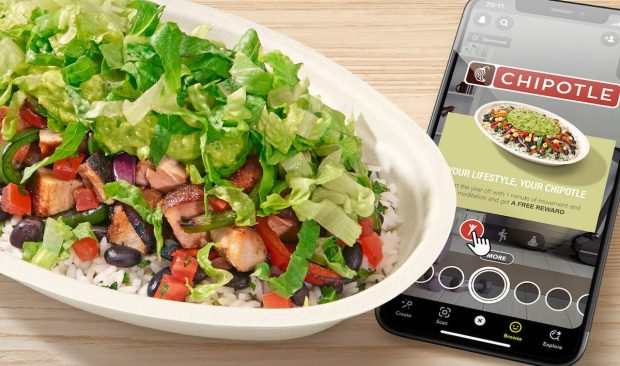Chipotle Rolls out ‘Extended Reality’ to Boost Burrito Bowl Sales

As restaurants look to distinguish useful innovation from flashy technology, Chipotle is testing extended reality (XR).
Stephanie Perdue, vice president of brand marketing at the fast-casual chain, explained in an interview with PYMNTS that the company’s latest augmented reality (AR) promotion, a branded Snapchat lens announced Tuesday (Jan. 3), draws from past success leveraging XR to drive sales.
The term XR includes virtual reality (VR), which refers to fully immersive digital experiences and AR, wherein digital content is laid over real environments, as well as mixed reality (MR), which is more immersive than AR but not fully virtual.
“With the right program and partners, extended reality can drive conversion,” Perdue said. “Last year, we saw a tremendous response to our fun, culturally relevant, and insight-backed activations.”
Perdue cited the example of a successful AR promotion last year wherein the company teamed with NHL team the Colorado Avalanche to make it look like a giant burrito bowl was absorbed into the rink. She did not offer specific sales figures, although the company’s return to XR suggests that the brand saw at least some success.
Certainly, when it comes to testing out XR initiatives to reach younger consumers, an AR lens on an established social media platform is a relatively safe bet compared to alternatives. Other brands, such as quick-service restaurant (QSR) giant Wendy’s, have been building out entire metaverse experiences, a more costly endeavor with a less established user base.
Yet consumer interest in the metaverse seems to be on the decline. Sales of VR headsets in the United States in 2022 fell 2% from a year earlier, CNBC reported, citing NPD data. Plus, the outlet noted, there was a 12% year-over-year decline in the number of global AR and VR headset units shipped, according to the analytics firm CCS Insight.
Chipotle, for its part, is leveraging AR to reach young consumers, targeting not only the social media platforms they frequent but also the lifestyle trends that resonate with them.
“We have taken [an] insight-driven approach with the Lifestyle Bowl campaign that taps into new Gen Z and millennial wellness trends to meet our guests where they are with relevant menu items,” Perdue said.
Indeed, Snapchat has a wide following with younger consumers. Perdue highlighted the platform’s 363 million daily active users, and the social media app’s parent company, Snap, noted last year that 80% of the U.S. Generation Z population watched original content on the app the year prior.
Notably, Gen Z actually lags behind most other generations when it comes to digital ordering, according to research from PYMNTS’ study “Super Apps for the Super Connected,” created in collaboration with PayPal. The report, which drew from a survey of more than 9,900 consumers across the United States, the United Kingdom, Australia and Germany, found that 61% of Gen Z consumers in these four countries ordered restaurant meals online for pickup or delivery in the prior month. In contrast, 70% of millennials, 68% of bridge millennials and 64% of Generation X consumers did the same.
While many businesses are looking to focus on the tech investments that will drive profit in the immediate term, prioritizing practical investments, Chipotle continues to tout the value of including flashy tech flourishes that attract attention in addition to applied solutions.
Perdue noted that, when considering new digital technologies, the brand looks for “anything that adds value for our guests, simplifies experiences for our team members or drives buzz and excitement for our fans.”
